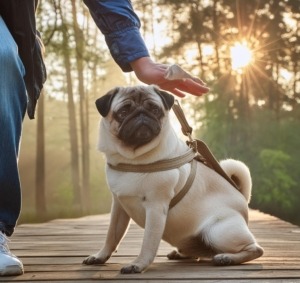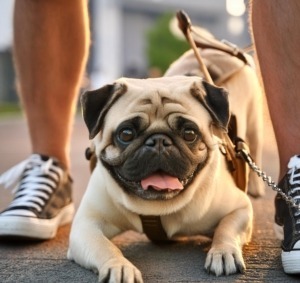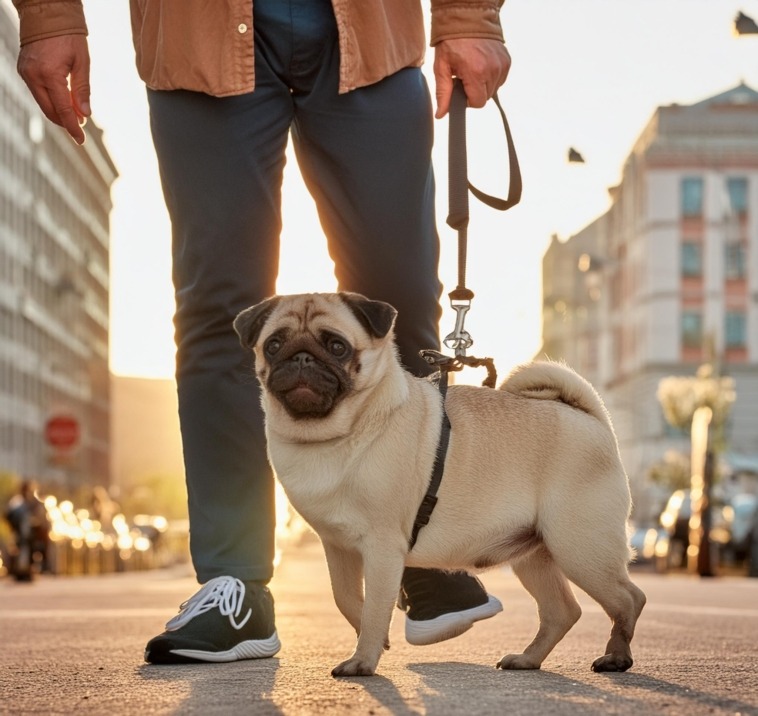Last updated on September 27th, 2024
Here’s an Overview:
Understanding the Mind of a Stubborn Pug
The Power of Positive Reinforcement
Socialization Techniques for Better Behavior
Effective Use of Commands and Hand Signals
Dealing with normal behavior difficulties
Implementing Reward-Based Training a Stubborn Pug
Ensuring Physical And Mental Stimulation
Patience And Persistence In Training a Stubborn Pug
When To Seek Professional Help for Training a Stubborn Pug
Understanding the Mind of a Stubborn Pug
A stubborn pug is usually just being true to his or her pugness. They might seem like they are refusing to be obedient because they are very independent and clever. It is important to know when your dog is being obstinate by ignoring commands or even misbehaving at times. Some things that could affect its behavior include:
- Breed Traits: Pugs are known for their independence.
- Short Attention Span: They can get distracted easily.
- Comfort over Exertion: Pugs would rather sleep than take long walks.
- Reward Driven: They respond well to treats.
After understanding these you should come up with an appropriate way of training them which involves patience, consistency as well as aligning methods used with their natural tendencies and motivation where possible among others.
Creating a Consistent Routine
When training a stubborn pug it is important to create and stick by some rules. This will make them understand what is expected of them hence feeling secure;
- Set Regular Feeding Times: Give your dog food at specific hours every day so that he knows when to expect it thus making his system well set. Allocate
- Training Sessions: You should have short focused sessions but frequently.
- Establish Potty Breaks: Take him out after meals or naps mainly; this helps in regulating bowel movements as well as ensuring cleanliness within its environment.
- Implement Commands Uniformly: Use one word command such “sit” followed by one reward like treat which work best for most dogs including pugs etcetera etcetera.

The Power of Positive Reinforcement
Positive reinforcement works wonders for a pug during training. In fact it increases the chances of him or her getting things right fast hence success Rewards:
- Treats: Small tasty treats are effective.
- Praise: Vocal praises can go along way in encouraging good behavior.
- Toys: Offer him his favorite toy whenever he does something good.
Timing is also very important here; always reinforce immediately after the desired behavior so that they can easily associate actions with rewards. Be firm but calm when giving out commands and avoid punishments which might make them scared or anxious. Create structure where necessary plus show patience and understanding as you shape your pet through positive reinforcement into being well behaved etcetera etcetera.
Socialization Techniques for Better Behavior
Introduce the pug to a variety of environments, people, and other animals early. Regular visits to busy parks, pet-friendly stores, and family gatherings can help the pug adapt.
- Gradual Exposure: Do not rush this process since it might overwhelm him.
- Positive Reinforcement: Reward him for staying calm and friendly during such times.
- Consistent Routines: Maintain regular schedules which build confidence while reducing anxiety levels especially among sensitive breeds like these ones.
- Playdates: Organize meetings between dogs from different households so that they can learn how to socialize properly۔
- Training Classes: Join group classes where there are many other pets undergoing obedience training; this way there will be more opportunities for them to interact socially etcetera etcetera.
Effective Use of Commands and Hand Signals
When training a stubborn pug, using commands together with hand signals can enhance communication between you two thus better results achieved
Consistency:
- Always use same command for one particular action
- Let all family members know these hand signs too
Clarity:
- Commands should be precise and simple
- Hand signals should be clear enough so that he sees what you want him to do without any confusion arising from them being too close together or alike in shape etc.
Repetition:
- Regular reinforcement of commands.
- Consistent practice of hand signals.
Positive Reinforcement:
- Treat or praise him whenever he obeys your instructions
- Training sessions should be short since pugs have a low attention span
Training sessions should be short and engaging to maintain the pug’s attention and interest.
Dealing with normal behavior difficulties
- Barking: Identify triggers. Use positive reinforcement to reward silence; use the word “quiet” consistently.
- Chewing: Give appropriate chew toys. Get rid of tempting items within reach. Watch and redirect if caught in the act.
- Pulling on Leash: Try no-pull harnesses. Use the “stop-and-go” technique. Reward when leash is loose.
- House Training: Keep a consistent schedule. Praise and treat immediately after a successful potty session. Clean accidents thoroughly to eliminate scent.
- Jumping: Ignore the dog when it jumps up on you (no touch, no talk, no eye contact). Reward only calm behavior, sitting or standing; not excited behavior like “off”. Train an alternative behavior such as “sit”.
Implementing Reward-Based Training a Stubborn Pug
In order for reward-based training to be effective there must be an emphasis placed on positive reinforcement techniques.
- Consistency: Rewards should be given immediately after desired behaviors are displayed.
- Valued Rewards: Use treats that are highly valued by dogs.
- Short Sessions: Keep training sessions short so your dog does not lose interest or focus.
- Verbal Praise: Pair treats with verbal praise to reinforce good behaviors shown by your dog during training sessions .
- Gradual Progression: Start off easy then slowly make things harder as time goes on .
- Avoid Punishment: Never punish your dog because this will cause them to become more stubborn about learning new things from you .
- Positive Environment: Always train in a relaxed setting where there isn’t any tension between you and your dog otherwise it may affect their ability to learn new commands or tricks from you۔
Using these steps will create a fun learning environment for both you and your furry friend .
Ensuring Physical And Mental Stimulation
To avoid having behavioral problems with pugs , it’s important that they get regular physical and mental stimulation. You can achieve this by :
- Daily Walks: Take them for at least two short walks a day to maintain their physical health as well as reduce pent up energy.
- Interactive Toys: Use puzzle toys which can challenge their brain and problem solving skills thus keeping them mentally active.
- Training Sessions: Have different types of training sessions where you involve commands , tricks or even agility exercises so that they remain focused and stimulated throughout the process.
“A tired dog is a good dog .”

- Socialization: Regularly introduce your pug to new people, pets and environments so that they can become more adaptable in different situations. It will also help prevent anxiety problems from arising later on in life when they are exposed to unfamiliar things or places.
Getting them involved in proper activities helps improve outcome during training since it requires concentration thus they are able to understand what needs to be done easily.
Patience And Persistence In Training a Stubborn Pug
A stubborn pug will require lots of both patience and persistence during its training period because these dogs are known for being independent thinkers who like doing things on their own terms. Therefore, it’s important to have consistent routines when teaching them new commands or behaviors since this is what usually works best with such breeds.
- Consistency: Train at the same time every day using similar methods until desired results are achieved
- Repetition: Practice a lot until behavior becomes second nature
- Positive Reinforcement: Rewarding good behavior strengthens learning
- Short Sessions: Pugs have short attention spans, so keep sessions brief
- Calm Communication: Always use calm voice tones as this creates peaceful atmosphere which enhances positive responses from these types of dogs.
- Adaptable Approach: Be flexible enough by adjusting techniques depending on individual temperaments displayed by your pug while taking into account its progress pace.
With firmness, calmness, and consistency; one can achieve anything even if it means training an extremely stubborn breed like a Pug.
When To Seek Professional Help for Training a Stubborn Pug
Professional help should be considered under the following circumstances:
- Persistent disobedience despite consistent training efforts.
- Aggressive behavior towards other animals or humans.
- Anxiety issues manifesting as destructive behavior or excessive barking.
- Health concerns impacting the dog’s ability to learn or respond.
- Lack of progress despite trying multiple training techniques.
In such cases, it is advisable that you seek assistance from a certified dog trainer or behaviorist who can be able to address these specific issues through personalized strategies which are more likely going result into success during subsequent sessions with your furry friend .
Article from: Abdullah (Senior Trainor)




